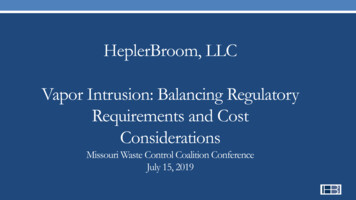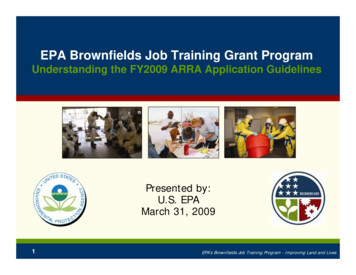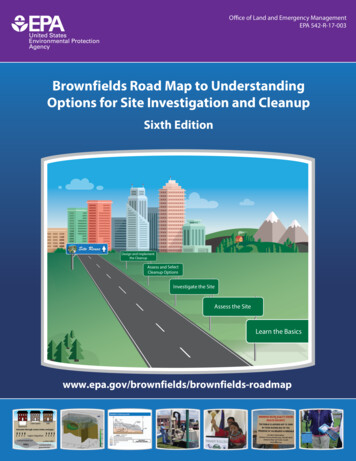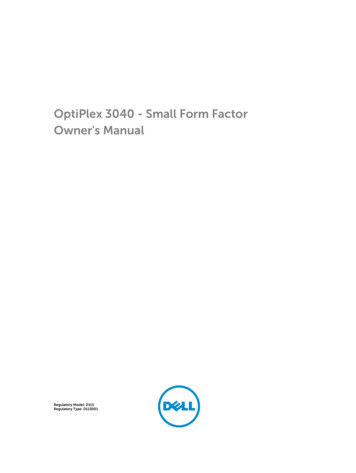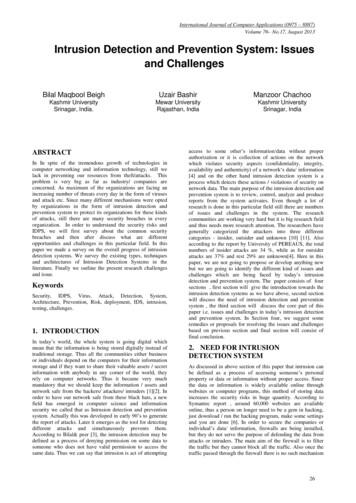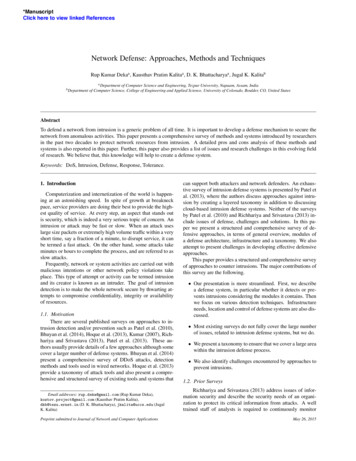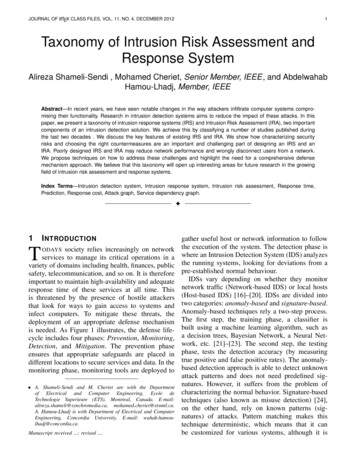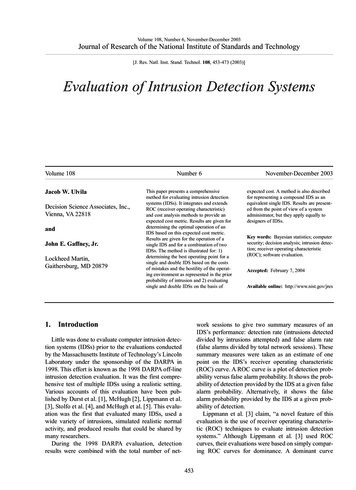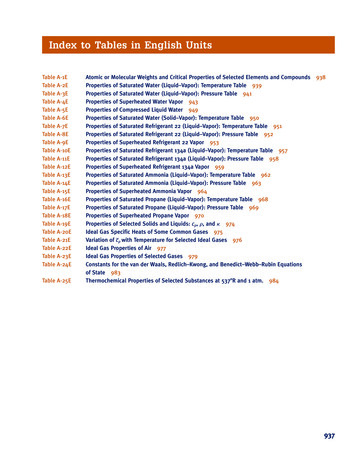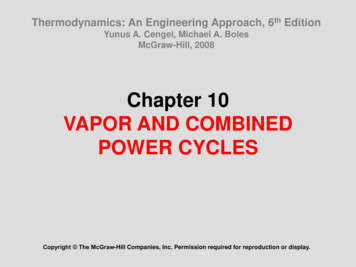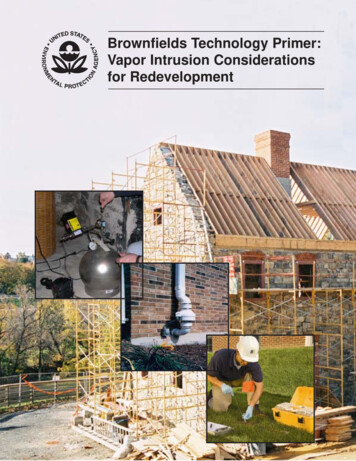
Transcription
Brownfields Technology Primer:Vapor Intrusion Considerationsfor Redevelopment
Solid Waste andEmergency Response(5203P)EPA 542-R-08-001March rownfields Technology Primer:Vapor Intrusion Considerationsfor RedevelopmentU.S. Environmental Protection AgencyOffice of Solid Waste and Emergency ResponseBrownfields and Land Revitalization Technology Support CenterWashington, DC 20460
BROWNFIELDS TECHNOLOGY PRIMERVAPOR INTRUSION CONSIDERATIONS FOR REDEVELOPMENTNotice and DisclaimerPreparation of this document was funded by the U.S. Environmental Protection Agency (EPA)under Contract No. 68-W-02-034. It was prepared for EPA’s Brownfields and LandRevitalization Technology Support Center (BTSC), which responds to requests from EPAregional offices, states, localities, and tribes to provide support for brownfield sites related tothe use of technology for site investigations and cleanups.The document is intended as a primer only, not guidance. EPA recommends that users refer toexisting guidance documents (some references are provided herein) regarding vapor intrusioncharacterization and mitigation techniques. The primer was subjected to the Agency’sadministrative and expert review and was approved for publication as an EPA document.Mention of trade names or commercial products does not constitute an endorsement orrecommendation for use.An electronic version of the primer can be downloaded from BTSC’s website athttp://www.brownfieldstsc.org. A limited number of hard copies are available free of charge bymail from EPA’s National Service Center for Environmental Publications at the followingaddress (please allow 4 to 6 weeks for delivery):EPA/National Service Center for Environmental PublicationsP.O. Box 42419Cincinnati, OH 45242Phone: 1-800-490-9198Fax: 301-604-3408Email: nscep@bps-lmit.comFor further information about this document, please contact Mike Adam of EPA’s Office ofSuperfund Remediation and Technology Innovation at 703-603-9915 or by e-mail atadam.michael@epa.gov.i
BROWNFIELDS TECHNOLOGY PRIMERVAPOR INTRUSION CONSIDERATIONS FOR REDEVELOPMENTTable of Contents1.0BACKGROUND . 11.1 What Is Vapor Intrusion? . 11.2 Why Is Vapor Intrusion a Concern? . 31.3 Where Is Vapor Intrusion a Concern?. 51.4 How Does Vapor Intrusion Impact Brownfields Redevelopment?. 51.5 How Is Vapor Intrusion Regulated and What Guidance Is Available? . 6Guidance Documents:. 6States: . 82.0ASSESSING THE POTENTIAL FOR VAPOR INTRUSION . 102.1 Developing the Conceptual Site Model . 102.2 Sampling and Analysis:. 11Groundwater and Bulk Soil Sampling:. 12Soil Gas Sampling. 12Passive Soil Gas Survey: . 14Sub-Slab Sampling: . 15Indoor Air Sampling:. 162.3 Using Predictive Models: . 173.0MITIGATION OF VAPOR INTRUSION. 193.0MITIGATION OF VAPOR INTRUSION. 193.1 Passive Mitigation Methods: . 20Sealing Cracks: . 20Passive Barriers: . 20Passive Venting: . 213.2 Active Mitigation Methods . 21Depressurization: . 21Sub-slab Soil Pressurization: . 22Building Pressurization:. 233.3 Strategies for New Construction . 233.4 Operation and Maintenance of Residential Systems . 244.0CONCLUSIONS. 25APPENDIX A: Know Your State! Available State Guidance Regarding Vapor Intrusion . 27APPENDIX B: Additional Sampling and Analysis Information . 31APPENDIX C: Acronyms and Glossary . 36APPENDIX D: References. 40ii
BROWNFIELDS TECHNOLOGY PRIMERVAPOR INTRUSION CONSIDERATIONS FOR REDEVELOPMENTList of FiguresFigure 1. Migration of Soil Vapors to Indoor Air . 4Figure 2. Installation of Soil Gas Probe Near House . 14Figure 3. Examples of Passive Soil Gas Samplers. 15Figure 4. Examples of Air / Soil Vapor Sample Collection Devices: Canister, Sampling Bags,and Sorbent Tubes . 17Figure 5. Schematic of Active Soil Depressurization System . 22List of TablesTable 1. EPA Regional Brownfields Coordinators . 9Table 2. Sampling Options for the Assessment of Vapor Intrusion. 13iii
BROWNFIELDS TECHNOLOGY PRIMERVAPOR INTRUSION CONSIDERATIONS FOR REDEVELOPMENT1.0BACKGROUNDRedevelopment of brownfield sites plays an important role in stimulating the economicrevitalization of communities by bringing vacant or underutilized properties into productive useand offsetting the need to develop open land, or “green space.” Along with the normal financialand business risks associated with developing property, brownfields redevelopers mustmanage environmental risk, including that due to vapor intrusion the migration of chemicalvapors from contaminated soil and groundwater into buildings. The core message of thisprimer is that early consideration of vapor intrusion beginning during the Phase I environmentalsite assessment will help ensure that redevelopment protects the health of current and futurebuilding occupants. In addition, incorporating relatively inexpensive mitigation (prevention)techniques into the construction of new buildings, rather than retrofitting them later, will resultin significant cost savings and help avoid the occurrence of vapor intrusion in the future.Because there are many available, cost-effective approaches to mitigation, vapor intrusionneed not stand in the way of brownfields redevelopment.This primer is designed for land revitalization stakeholders 1 concerned about vapor intrusion,including property owners, municipalities, and real estate developers. It provides an overviewof the vapor intrusion issue and how it can affect redevelopment. It also summarizestechniques for quickly and cost effectively assessing the potential for vapor intrusion, as wellas techniques for mitigating it.The topics covered will familiarize stakeholders with options for addressing vapor intrusion tohelp them communicate with their project contractors and consultants. The “Quick Look” box atthe beginning of each section summarizes the important points that follow. For reference, a listof acronyms and a glossary are provided in Appendix C. Text boxes throughout the primer andAppendices B, C, D, and E provide additional detail and resources for those readers whowould like to know more.1.1What Is Vapor Intrusion? Vapor intrusion is an exposure pathway a way that peoplemay come in contact with environmental contaminants. Vapor intrusion exposes buildingoccupants to potentially toxic levels of vapors when volatile chemicals (those that readilyevaporate) present in contaminated soil or groundwater emit vapors that migrate into overlyingbuildings. It is similar to the more familiar problem of radon, a gas that is emitted naturally fromsoil and bedrock and enters buildings through cracks and openings in the foundation andthrough porous building materials. (Text box 1.)Both volatile chemicals and semivolatile chemicals (those that evaporate more slowly) canpose a vapor intrusion problem. Examples of volatile and semi-volatile chemicals includedegreasers, dry-cleaning solvents, gasoline and petroleum (including benzene), naphthalene,polychlorinated biphenyls (PCBs), and certain pesticides. Volatile chemicals are primarily1This primer is not intended for audiences requiring in-depth technical explanations or guidance related to vaporintrusion.1
BROWNFIELDS TECHNOLOGY PRIMERVAPOR INTRUSION CONSIDERATIONS FOR REDEVELOPMENTA Quick Look at Vapor IntrusionDetermining the potential for vapor intrusion should begin early during the Phase I environmental siteassessment.Vapor intrusion exists when volatile or semivolatile chemicals in soil or groundwater migrate towardbuildings and enter through cracks and openings in the foundation and walls.Inhalation of vapors may cause chronic and acute health effects.The potential for vapor intrusion exists even though industrial activities may have never occurred on aproperty.States may have specific vapor intrusion guidance that needs to be considered.The Interstate Technology and Regulatory Council’s guidance documents describe a “multiple lines ofevidence” approach to assessing vapor intrusion.Contact environmental agencies to ensure that the most up-to-date and appropriate guidance is followed.organic but also comprise metallic mercury, which is inorganic. For ease of discussion, thisprimer refers to chemicals that may result in vapor intrusion as volatile organic compounds, or“VOCs.” (Other references may refer to “volatile chemicals of concern” or “vapor-formingchemicals.”) However, it distinguishes between volatile and semivolatile, as well as organicand inorganic chemicals, whereTEXT BOX 1: VAPOR INTRUSION AND RADONnecessary.As illustrated in Figure 1, VOCs incontaminated soil and groundwater emitvapors that rise through the pore spaceof the unsaturated zone above thewater table. (Where bedrock underlies aproperty, the vapors move throughfractures and openings in the rock.)These vapors, also known as “soil gas,”can move laterally as well as verticallyfrom the source of contamination.Lateral movement can increase asgroundwater plumes migrate away fromthe source of contamination or if theground surface is paved or frozen,preventing escape of vapors upwards.The movement of soil gas is controlledby the processes of diffusion andadvection. Diffusion causes vapors toVapor intrusion is similar to the behavior of radon. As aresult, the mitigation approaches developed for vaporintrusion are often similar to those for radon. Radon, acolorless, odorless gas, is formed from the decay ofradium, a radioactive element that occurs naturally in thebedrock and soil in some areas of the country. Radonposes a threat to the health of building occupants once thegas migrates at high enough levels from soil and rock intohomes and the work place. According to EPA estimates,inhalation of toxic radon decay products is the leadingcause of lung cancer among non-smokers. For moreinformation and EPA recommended action levels, y, testing for radon in buildings is common, as is theinstallation of mitigation systems to prevent entry of radon.Buildings also may be retrofitted to mitigate the problem.As testimony to the effectiveness of these mitigationmethods, nearly two million radon retrofits have beeninstalled and more than a half million homes have beenconstructed using radon reduction techniques. For moreinformation on radon mitigation, read EPA’s guide, BuildingRadonOut (EPA, 2001).2
BROWNFIELDS TECHNOLOGY PRIMERVAPOR INTRUSION CONSIDERATIONS FOR REDEVELOPMENTspread from the higher concentrations closest to the source of contamination toward lowconcentrations in uncontaminated areas. Advection is the movement of soil gas from areas ofhigher to lower pressure.As diffusion causes vapors to rise through soil or bedrock, they tend to accumulate underbuilding foundations and other barriers such as pavement. These barriers create a “cappingeffect,” which inhibits upward movement of vapors. Because of cracks and other openings inbuilding foundations, these barriers are not impenetrable. Vapor intrusion generally occurswhen advection (movement due to pressure differences) draws vapors indoors via theseopenings. The pressure beneath a building is typically higher than the pressure indoors due toa phenomenon called “building depressurization.” Depressurization causes buildings to drawsoil gas indoors. Soil gas that does not pass within the zone of influence of the building willcontinue to migrate within the subsurface or escape to the atmosphere. Vapors that passwithin the zone of influence will be drawn in through cracks in the foundation or throughopenings associated with utility lines, sump pumps, etc.Depressurization is caused by “leaky” heating and ventilation systems, exhaust fans, and stackand wind effects (Figure 1) that reduce the pressure indoors. Stack effects cause buildingdepressurization as a result of differences in indoor and outdoor temperatures. As warmerindoor air rises and exits the top of the building, the resulting pressure differences inducevapor flow into the bottom of the building. Stack effects can transport vapors to upper floors ofa building via stairwells, elevator shafts, ductwork, etc. Wind currents passing over a buildingcan also cause pressure differences that affect the flow of vapors into the building. For moreinformation on stack and wind effects, consult EPA’s Indoor Air Guide .2Why Is Vapor Intrusion a Concern? Vapor intrusion poses a potential risk to thehealth of residents, workers, and other occupants who breathe the vapors inside buildings. Inthe past, cleanup of brownfields and other contaminated sites focused on protecting humanhealth by preventing exposure to contaminants through direct contact (e.g., children playing incontaminated soil) or ingestion (e.g., residents drinking contaminated groundwater from wells).As we have learned more about vapor intrusion, however, it has become clear that thepotential for risk of inhaling chemical vapors due to vapor intrusion may still need to beaddressed.If vapor intrusion is a concern at a property to be developed, we recommend that a riskassessment by qualified personnel be conducted to evaluate the degree of risk to futurebuilding occupants. The question of risk posed to building occupants by vapor intrusion willdepend on the toxicity of the chemical, the concentration of the chemical vapor in the indoorair, the age and health of the occupants, the amount of time the occupants spend in thebuilding, and other variables. In rare instances, and in extreme cases, significant buildup ofvapors from a nearby highly contaminated source (e.g., gasoline from leaking undergroundstorage tanks or methane from landfills) may pose an immediate risk of fire or explosion. Inother cases, at concentration levels often associated with a detectable odor, short-termexposures may cause acute health effects such as headache, nausea, and eye and respiratoryirritation. But more commonly, the potential risk to building occupants comes from inhaling,3
BROWNFIELDS TECHNOLOGY PRIMERVAPOR INTRUSION CONSIDERATIONS FOR REDEVELOPMENTover time, lesser amounts of chemical vapors that have accumulated indoors. Thecontamination may not have a detectable odor; however, long-term exposure to even lowlevels of certain vapors may increase the risk of chronic health effects, such as cancer andother diseases.Figure 1. Migration of Soil Vapors to Indoor Air. Three conditions must exist for environmentalcontaminant vapors to reach the interior of buildings: vapors from contaminated soil or groundwater mustmigrate to the subsurface near the building foundation, entry routes into the building must be present, andthere must be driving forces (e.g., stack and wind effects) present that can move the vapors through theseentry routes (ASTM, 2005).4
BROWNFIELDS TECHNOLOGY PRIMERVAPOR INTRUSION CONSIDERATIONS FOR REDEVELOPMENT1.3Where Is Vapor Intrusion a Concern? Vapor intrusion is a potential concern at anybuilding existing or planned located near soil or groundwater contaminated with VOCs.EPA’s draft guidance for evaluating the vapor intrusion pathway defines “near” ascontamination within 100 feet (laterally or vertically) of buildings, unless there is a conduit thatintersects the soil gas migration route that would allow soil gas to migrate further than 100 feet(EPA, 2002). A conduit is any passageway, such as a sand or gravel layer, buried utility line, oranimal burrow, that facilitates the flow of soil gas. The guidance further notes that vaporintrusion is associated with contamination found in the unsaturated zone (the soil above thewater table) or in the uppermost portion of the saturated zone (just below the water table) asopposed to deep within the saturated zone. Fluctuations in the water table level due toseasonal precipitation changes or pumping may increase soil gas concentrations wherecontamination exists.Properties with potential VOC contamination are common in industrial and commercial areas.They include current and former manufacturing and chemical processing plants, warehouses,landfills, coal gasification plants, train yards, dry cleaners, and gas stations. Improper use,storage, or transport of chemicals at these facilities may have resulted in a release ofcontaminants to the environment creating the potential for future vapor intrusion issues. Inaddition to industrial and commercial activities, roadside dumping, pesticide spraying, or evenimproper disposal of household chemicals via a septic field may also release contaminants tothe environment. Therefore, the potential for vapor intrusion should be considered at all typesof properties considered for redevelopment.Even “greenspace” properties that have not previously been occupied or developed maycontain VOC contamination. Because groundwater plumes and soil gas can migrate laterally,the contamination source need not be on the property to be redeveloped to pose a vaporintrusion problem. The actual source(s) of vapor intrusion (e.g., landfill wastes, contaminatedsoil, or buried drums) may be present on a neighboring property or on a property somedistance away. Depending on the degree of contamination and geology, contaminantsdissolved in groundwater plumes can flow beneath a property from sources located a mile ortwo upgradient (in the direction opposite groundwater flow and plume migration). Because ofthe large size of migrating groundwater plumes, they may be the greatest contributor to thevapor intrusion problem.1.4How Does Vapor Intrusion Impact Brownfields Redevelopment? Awareness ofvapor intrusion as a potential for exposure to soil and groundwater contamination has raisedconcerns about public health risks and liability during property transactions. However, if vaporintrusion is considered along with other potential exposure pathways commonly evaluated(e.g., ingestion of or direct contact with soil and groundwater), land revitalization stakeholderscan eliminate potential health risks and facilitate transactions. Early proactive evaluation ofvapor intrusion can make available more options for the mitigation and redevelopment. Inaddition, preconstruction mitigation measures are less expensive than post-constructionremediation and structure retrofits.The potential for vapor intrusion should be considered during the Phase I or the follow-onPhase II environmental site assessment for any brownfield property transaction. This would5
BROWNFIELDS TECHNOLOGY PRIMERVAPOR INTRUSION CONSIDERATIONS FOR REDEVELOPMENTinclude looking at the past history of the property, neighboring properties, site geology andhydrogeology, and the condition of existing buildings for conditions conducive to vaporintrusion. If the potential is found to exist, then an appropriate sampling and analysis plan forsite characterization can be developed in Phase II so that vapor intrusion can be evaluatedand mitigated. (These topics are discussed further in Sections 2.0 and 3.0, respectively.)Subsequent changes in the use of a property, such as converting an industrial building to loftapartments, may require reevaluation of the vapor intrusion pathway (EPA, 2002).The American Society for Testing and Materials (ASTM) is developing a standard to addressvapor intrusion as it can impact real estate transactions (Buonicore, 2006). The standard willsupplement the Phase I environmental site assessment process and can be designed to helpdecide whether or not there is a reasonable probability that vapor intrusion could present anenvironmental risk or liability.1.5How Is Vapor Intrusion Regulated and What Guidance Is Available? Vaporintrusion is an exposure pathway, and as an exposure pathway, it should be considered byenvironmental practitioners when evaluating potential health risks from soil or groundwatercontaminated with VOCs. Both EPA and state agencies recognize the importance of thispathway and have issued guidance documents to guide practitioners in their assessment ofthe vapor intrusion pathway. In addition, several state documents also provide guidance forevaluating and mitigating the potential health risks. At the time of this writing, however, neitherEPA nor the states regulate how assessments and mitigation must be performed.Guidance Documents: EPA issued the OSWER 2 Draft Guidance for Evaluating the VaporIntrusion to Indoor Air Pathway from Groundwater and Soils in 2002. The premise of theOSWER draft guidance is to use sampling data collected from outside the building, such assoil gas, sub-slab, and/or groundwater samples discussed in Section 2.2, to estimate indoor airconcentrations of vapors. These estimates are compared to risk-based concentrations forindoor air in residential settings. The guidance also allows evaluation of non-residentialsettings through use of the Johnson and Ettinger or “J&E” model (See Section 2.3). Use of theOSWER draft guidance is not recommended typically for sites with petroleum-relatedcontamination, such as former gas stations (Text box 2).The draft guidance (EPA, 2002) suggests beginning assessment with the development of aconceptual site model (CSM; a depiction of site conditions, see section 2.1) and leads the userthrough a series of questions arranged in a three-tiered approach. If at any time in the threetiered approach insufficient data are available to answer the questions posed, the EPA (2002)draft guidance recommends the collection of additional samples and site information. Anindication of a complete pathway requires an assessment of the risk resulting from breathingthe indoor air. If at any time during the approach the vapor intrusion pathway can be ruled“incomplete,” there is no need to proceed further. However, if site conditions or uses change inthe future, the site would be re-evaluated to determine if a complete pathway has developedand mitigation is now necessary. For more information on this guidance, htm.2OSWER is EPA’s Office of Solid Waste and Emergency Response.6
BROWNFIELDS TECHNOLOGY PRIMERVAPOR INTRUSION CONSIDERATIONS FOR REDEVELOPMENTThe Interstate Technology & Regulatory Council (ITRC) a coalition of states, the District ofColumbia, tribal and industrial representatives, and several federal partners recentlypublished Vapor Intrusion Pathway: A Practical Guideline (2007a), which is a frameworkintended for use with existing state and federal guidance or policy. This frameworkincorporates multiple lines of evidence and follows a 13-step approach to evaluating thepotential for vapor intrusion. Lines of evidence include the locations of sources, distribution ofgroundwater contaminants and soil gas at the site, sub-slab concentrations (soil gas beneathbuilding foundations), indoor and outdoor air concentrations, background concentrations,presence of conduits, and building construction plans or details. This approach helpsdetermine whether a site warrants no further action, additional investigation, or mitigation.ITRC emphasizes the importance of developing an accurate CSM that is representative of siteconditions, so that it can be used to assist with planning and make sure the site data is usedproperly. This guidance also provides detailed information on site investigation and mitigationapproaches.ITRC’s companion document, Vapor Intrusion Pathway: Investigative Approaches for TypicalScenarios (2007b), walks users through using the guidance for varying scenarios, such asdifferent contaminated properties (e.g., service station, dry cleaner, and industrial facility) anddifferent receptors (e.g., residential neighborhood, commercial building, and a vacant lot withproposed brownfields development).EPA has also published Guidance for Evaluating Landfill Gas Emissions from Closed orAbandoned Facilities (EPA, 2005a). This guidance provides procedures and a set of tools forevaluating landfill gas emissions to ambient air, soil gas migration due to landfill-gas pressuregradients (differences in pressure), as well as vapor intrusion into buildings. The risks ofinhaling vapors can be evaluated, in addition to the hazards of both on-site and off-sitemethane explosions and landfill fires.TEXT BOX 2:THE DRAFT EPA GUIDANCE AND PETROLEUM-CONTAMINATED SITESAvailable scientific literature suggests that petroleum contamination biodegrades more readilythan most other types of VOCs; in other words, microbes found naturally in the soil can breakdown petroleum into less harmful compounds relatively quickly. Although the OSWER draftguidance allows observations of the effects of biodegradation to be considered in its approach,it does not predict the effects of biodegradation. As a result, application of the draft guidance topetroleum compounds may overestimate the impact of vapor intrusion, if observations are notconsidered. As a result, as mentioned in Section 1.5, the guidance recommends using theapproach documented in Use of Risk-Based Decision Making in UST Corrective ActionPrograms (EPA, 1995a) to assess vapor intrusion at petroleum-contaminated sites.Additional technical information is available from ITRC (2007a, b) and API (2005), while somestate guidance documents, California’s and New Jersey’s, for example (Appendix B), providemore specific direction about how to evaluate biodegradation as a factor in reducing vaporintrusion at petroleum sites.7
BROWNFIELDS TECHNOLOGY PRIMERVAPOR INTRUSION CONSIDERATIONS FOR REDEVELOPMENTStates: As of this writing, at least 21 states have issued guidance documents dealing withvapor intrusion. State guidance, where it exists, supersedes the existing EPA guidancedocuments. The specific state documents and the URLs for finding them on the Internet arelisted in Appendix A. As is evident by the titles, state guidance documents range in scope andaddress varying issues related to vapor intrusion. Several state documents, like Ohio’sMethodology for Vapor Intrusion Assessment, base their approach to assessing vapor intrusionon the OSWER draft guidance, but have modifications. Therefore, it is recommended thatrelevant state agencies be contacted concerning vapor intrusion issues to ensure appropriateguidance is followed.Because awareness and concern for vapor intrusion continues to grow and the science andtechnology behind it continues to improve, new documents are likely to be published soon andexisting ones replaced. Therefore, stakeholders should contact appropriate state agencies toensure that the most up-to-date and appropriate guidance is followed. A list of contacts can befound at: http://www.itrcweb.org/vaporintrusionresources/4 2 07VI contact list.xls.Stakeholders also may contact their EPA Regional Brownfields Coordinator, listed in Table 1,for information on brownfields and assistance with their vapor intrusion questions.TEXT BOX 3: ITRC’S SURVEY OFSTATES ON VAPOR INTRUSIONIn 2004, the ITRC conducted a survey regardingvapor intrusion regulations. A total of 41 stateagencies and Canada responded. The surveyresults, which include responses to qu
in significant cost savings and help avoid the occurrence of vapor intrusion in the future. Because there are many available, cost-effective approaches to mitigation, vapor intrusion need not stand in the way of brownfields redevelopment. This primer is designed for land revitalization stakeholders1 concerned about vapor intrusion,
